

How to Use Social Media as a Learning Tool. Social media is an ingrained part of today’s society.
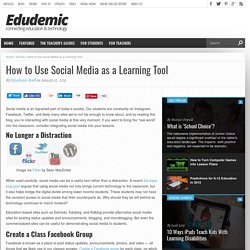
Twitter gets an A+ in kindergarten classroom. Schools are using technology in the classroom at an increasingly rapid rate.
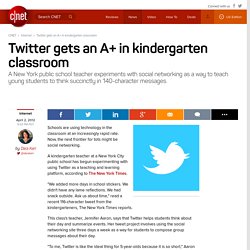
Now, the next frontier for tots might be social networking. A kindergarten teacher at a New York City public school has begun experimenting with using Twitter as a teaching and learning platform, according to The New York Times. "We added more days in school stickers. We didn't have any lame reflections. We had snack outside. This class's teacher, Jennifer Aaron, says that Twitter helps students think about their day and summarize events.
"To me, Twitter is like the ideal thing for 5-year-olds because it is so short," Aaron told The New York Times. All I Really Need to Know I Learned in Kindergarten: How to Use Twitter From Kindergarten to College. 6.14.12 | As Twitter continues to make more inroads into academic spaces, two recent articles demonstrate its use across the educational spectrum.
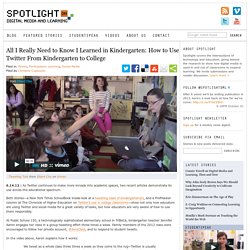
Both stories—a New York Times SchoolBook inside-look at a tweeting class of kindergarteners, and a ProfHacker column at The Chronicle of Higher Education on Twitter’s use in college classrooms—show not only how educators are using Twitter and social media for a great variety of tasks, but how educators are very aware of how to use them responsibly. At Public School 150, a technologically sophisticated elementary school in TriBeCa, kindergarten teacher Jennifer Aaron engages her class in a group tweeting effort three times a week. Family members of the 2012 class were encouraged to follow her private account, @JensClass, and to respond to student tweets. Social media project has Jeffersonville students a-Twitter.
Just a few days into the school year, fourth-graders at Northaven Elementary in Jeffersonville are learning to compose their thoughts on paper using 140 characters or less, as well as what information they should and shouldn't post online. Students are given time to think before they write practice tweets on light blue note cards that line one of the classroom walls, including Jaleb Treat's contribution about email addresses being among the personal information that should be kept private, an idea he got from his teacher. "I think it's hard to put all of my thoughts into one sentence," Jaleb, 9, said about tweeting in an interview moments later. Around the end of next month, the students will begin a new classroom duty, maintaining a protected classroom Twitter account that teacher Lindsay Lawrence plans to use to have them share "smile moments" about their experiences inside and outside the classroom.
Autoplay Show Thumbnails Show Captions "We want teachers to tell their stories. NAESP. By Debbie Marsh Communicator February 2015, Volume 38, Issue 6 At South Elementary School in Mooresville, North Carolina, we used the 100th day of school last year to explore technological advances.
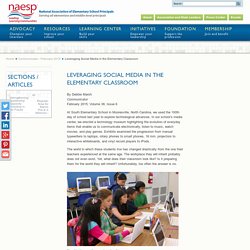
In our school’s media center, we erected a technology museum highlighting the evolution of everyday items that enable us to communicate electronically, listen to music, watch movies, and play games. Exhibits examined the progression from manual typewriters to laptops, rotary phones to smart phones, 16 mm. projectors to interactive whiteboards, and vinyl record players to iPods. The world in which these students live has changed drastically from the one their teachers experienced at the same age.
The workplace they will inherit probably does not even exist. The Challenge: Connecting the Classroom. Introducing Social Media to Elementary Students. Social networking in kindergarten. Using social media to connect families and kindergarten classrooms - D-Scholarship@Pitt. Zywica, Jolene (2014) Using social media to connect families and kindergarten classrooms.
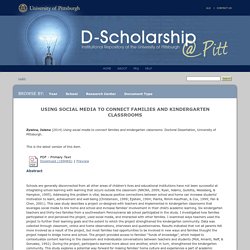
Doctoral Dissertation, University of Pittsburgh. This is the latest version of this item. Abstract Schools are generally disconnected from all other areas of children’s lives and educational institutions have not been successful at integrating school learning with learning that occurs outside the classroom (NRCNA, 2009; Ryan, Adams, Gullotta, Weissberg, & Hampton, 1995). Addressing this problem is vital, because positive connections between school and home can increase students’ motivation to learn, achievement and well-being (Christenson, 1999; Epstein, 1994; Pianta, Rimm-Kaufman, & Cox, 1999; Fan & Chen, 2001). Social Media and Blogging in Kindergarten. Social media and blogging in kindergarten is where I begin to model explicitly how I get my students and their families connected.
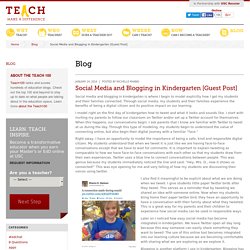
Through social media, my students and their families experience the benefits of being a digital citizen and its positive impact on our learning. I model right on the first day of kindergarten how to tweet and what it looks and sounds like. I start with inviting my parents to follow our classroom on Twitter and/or set up a Twitter account for themselves. When this happens, our conversations begin. I ask parents that I know are familiar with Twitter to tweet at us during the day.
Right away, I have an opportunity to model the importance of being a safe, kind and responsible digital citizen. How to Use Social Media to Strengthen Student Writing. Rusul Alrubail , Writer on education, teaching and learning.
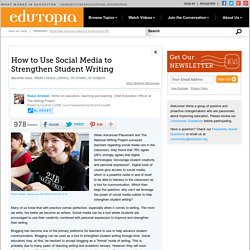
Chief Education Officer at The Writing Project Posted 02/13/2016 7:50PM | Last Commented 03/18/2016 4:24AM When Advanced Placement and The National Writing Project surveyed teachers regarding social media use in the classroom, they found that 78% agree (26% strongly agree) that digital technologies “encourage student creativity and personal expression”. Saying Yes to Digital Media in Preschool and Kindergarten. You, a parent of young children, may be tethered to your phone, iPad and laptop.
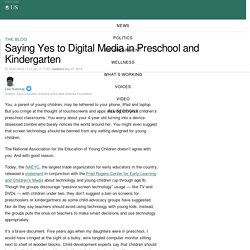
But you cringe at the thought of touchscreens and apps slinking into your children’s preschool classrooms. You worry about your 4-year-old turning into a device-obsessed zombie who barely notices the world around her. You might even suggest that screen technology should be banned from any setting designed for young children. The National Association for the Education of Young Children doesn’t agree with you. And with good reason. Today, the NAEYC, the largest trade organization for early educators in the country, released a statement in conjunction with the Fred Rogers Center for Early Learning and Children’s Media about technology and young children (up through age 8).
It’s a brave document. But the last few years of touchscreen technologies, digital photography and Internet video calls (i.e. The NAEYC statement doesn’t delve into what parents should be doing at home with their kids. Can Social Networking Boost Literacy Skills? The findings of two recent literacy studies in Great Britain will come as no surprise to many parents and may also help to explain why students are reluctant to do homework.
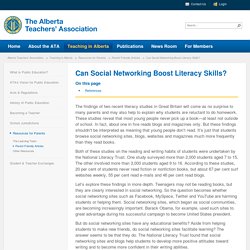
These studies reveal that most young people never pick up a book—at least not outside of school. In fact, about one in five reads blogs and magazines only. But these findings shouldn’t be interpreted as meaning that young people don’t read. It’s just that students browse social networking sites, blogs, websites and magazines much more frequently than they read books. Both of these studies on the reading and writing habits of students were undertaken by the National Literacy Trust.
Let’s explore these findings in more depth. But do social networking sites have any educational benefits? According to one of the studies, 49 per cent of young people believe that writing is “boring.” The study also explored why young people who lack confidence in their writing ability perceive themselves to be poor writers.